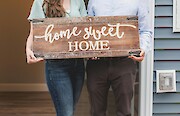Meeting monthly mortgage repayments can be challenging today, particularly if you purchase a property on your own. As a result, many homeowners choose to become a live-in landlord. Unlike a traditional landlord, a live-in landlord does not require a specialist buy-to-let mortgage; they simply need a spare room in their main residence to let to a lodger.
Below, we explain how to rent a room when you already have a mortgage, outline what a lodger mortgage involves, and show how taking in a lodger could, in some cases, support an application for a larger mortgage.
Can you rent out a room in your house on a normal mortgage?
In most cases, lenders will let you use the rent-a-room approach while on a standard residential mortgage. That said, policies vary, so you should review your mortgage terms and conditions before taking in a lodger.
Although this can be a sensible way to increase your income, you must tell your lender if you plan to become a live-in landlord. Even where your terms and conditions appear to permit lodgers, some lenders—such as NatWest—include a clause that requires you to obtain permission before the lodger moves in.
Can you get a bigger mortgage if you rent-a-room?
Yes—some lenders will include lodger income in your affordability assessment, which can increase your borrowing capacity and, in turn, your potential loan size.
This approach is often labelled a “lodger mortgage” or “rent-a-room mortgage”. In practice, it is a standard residential mortgage where the lender is willing to factor verified lodger income into the loan calculation. Only a limited number of lenders offer this, and each applies its own rules to taking in a lodger.
At Money Helpdesk, we can point you to specialist lenders that accept a lodger’s rent—alongside other non-standard income—within their affordability models. Speak with a mortgage broker for tailored guidance.
How to obtain a mortgage using lodger income
Most eligibility checks mirror a typical residential application: affordability, credit history, age limits, and property criteria.
In addition, you will usually need to meet lodger-specific conditions, which differ by lender but commonly include:
-
Proof of lodger income, usually via bank statements.
-
A written lodger agreement may be required, setting out the rent, payment terms and any agreed end date.
-
Some lenders allow only one lodger; others may permit more.
-
Lodgers are generally not permitted to be close family members.
-
Typical maximum loan size around £250,000.
-
Maximum loan-to-value usually about 80% LTV (i.e., 20% deposit).
-
Some lenders will only count lodger income up to the £7,500 tax-free limit under the Rent-a-Room Scheme.
-
The proportion of lodger rent counted varies: many use 50%, while a few may consider up to 100% where you can evidence roughly two years of consistent receipts.
Even where a lender accepts 100% of lodger income, it is unlikely you will secure a mortgage based on lodger income alone. You will still need to evidence at least one other stable source of income when you apply.
Which mortgage lenders accept lodger income?
Not all lenders that permit lodgers will also accept lodger income in their affordability checks. While more than 30 lenders allow lodgers under standard mortgage terms, only a small subset will include rent from a lodger in your income assessment.
Some lenders limit this to remortgages, as most will want a track record of lodger income for a set period before counting it.
Below are examples of lenders that may take some or all lodger income into account in their loan calculations:
-
Santander – may allow up to two lodgers at once.
-
Bath Building Society – offers a dedicated rent-a-room mortgage to a maximum of 80% LTV, capital repayment only, and may consider up to 100% of lodger income.
-
Norton Home Loans – may accept up to 75% of lodger income with a lodger agreement and supporting bank statements.
-
Vernon Building Society – may consider up to 50% with three months’ bank statements, or up to 100% with 24 months’ evidence.
-
Dudley Building Society – may include lodger income but only up to the Rent-a-Room tax-free threshold.
-
Loughborough Building Society – may accept up to 50% if the lodger has lived with you for at least three months.
-
Darlington Building Society – may consider up to 75% of lodger income, capped at the Rent-a-Room tax-free limit; available via intermediaries only.
If you plan to take on a lodger—either in your current home or when you purchase a new property—get in touch today to discuss your options with a broker.
Frequently Asked Questions
The Government’s Rent a Room Scheme lets you earn up to £7,500 per tax year in total from letting furnished accommodation in your main home tax free. If your gross receipts stay within this allowance, you normally do not need to declare the income to HMRC (unless you already complete a Self Assessment for other reasons). If you go over the allowance, you must report the income and either use the £7,500 relief or pay tax on your actual profit.
For context, £7,500 per year is roughly £144 per week. Note this limit is not per lodger; it’s the overall annual threshold for the scheme. If the income is shared (for example, joint owners), the allowance is halved to £3,750 each.
To be eligible, you must:
-
Live in the property as your only or main home.
-
Provide furnished accommodation to the lodger.
-
Carry out a right to rent check to confirm the lodger is legally allowed to rent in England.
If you’re charging rent, right to rent checks are a legal requirement for lodgers in England, and you can complete them using the Home Office guidance and online service.
















